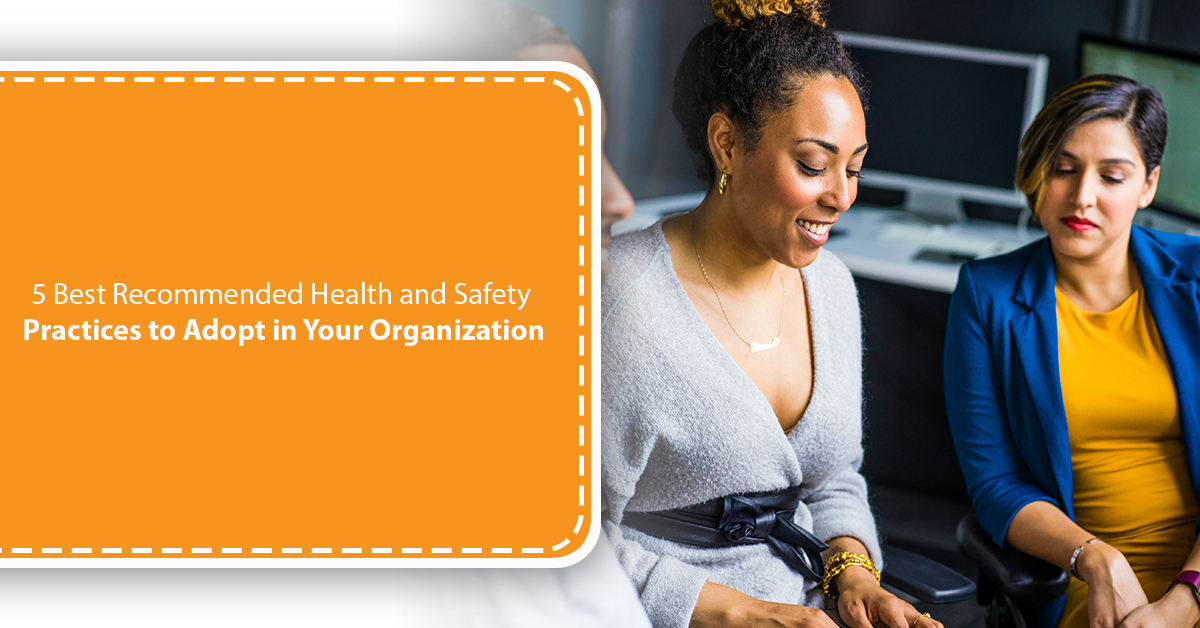5 Best Recommended Health and Safety Practices to Adopt in Your Organization
Organizations need to have a strict management program or a framework of practices to ensure the safety and wellbeing of their workers. Workplace risks or work-related injuries are quite common, especially in labor-intensive sectors like construction, manufacturing, chemical production, energy and oil, agriculture, and health. Even the service-based organizations which comparatively have lower risks need a health and safety program too today to keep their workers safe during a health pandemic like COVID-19. The main goal for organizations should be to have a set of health and safety practices for protecting their workers from any workplace inconveniences, injuries, sicknesses, or mental stress. The recommended practices must be communicated to the workers at all levels, and they should be provided with adequate training to follow them. In other words, employers as well as the workers are collectively responsible for workplace safety and so need to be proactive together in following the practices.
In this blog, we have highlighted five key practices that organizations should employ to prevent hazards and mitigate risks in their workplaces.
Favorable Health and Safety Practices that Make Workplaces Safer for Your Employees
1. Hazard/Risk Identification
To prevent risks and protect your workers, what you first need is hazard identification and assessment procedures. It must be an integral safety practice where a delegated OHS (Occupational Health and Safety) team would be responsible for regular on-site assessments to find risks or probable hazards. The purpose of this practice is to make your employees aware of the OHS risks and help them understand the procedures required to make their worksites safe. Usually, the hazard recognition and assessment practices are conducted with a checklist or risk matrix. In that way, the team decides some specific criteria to classify risks as OHS risks and prioritize them. Accordingly, they can plan to implement new measures, initiate changes in the work procedures, and make provisions for safety kits or equipment.
2. Handling of Hazardous Items/Work Equipment
One of the crucial OHS practices is the proper handling of hazardous inputs or raw materials which are needed in the manufacturing processes. Careful handling of risky work equipment or machinery is also necessary. Knowing the correct ways to handle materials or operate equipment could save the employees from severe injuries or accidents. Hazards like chemical gas leakage, spillage of oil or flammable liquids, release of asbestos-containing materials, etc. are not just harmful to the workers’ health but also to the environment. Similarly, harness failure, repetitive motion injuries, electrical faults, fire accidents, slips and falls, fractures, etc. are accidents that can happen while working with machines or working in a physically challenging environment.
Thus, a key OHS practice involves assessing the hazardous materials, work machines and environment to provide workers with effective safety protocols. Also, there must be some designated areas to store the materials. The workers should be provided with necessary safety gear or PPEs (Personal Protective Equipment) whenever they had to work with risky machinery or in a hazardous situation.
3. Emergency Preparedness
Despite all the precautionary measures and safety practices, organizations especially with risk-prone workplaces should always have emergency preparedness and recovery actions. Proper emergency and evacuation procedures are necessary to prevent risks of severe injuries to workers or fatalities while they are occupied at their jobs. When evacuation procedures are already planned and workers are trained in them, it minimizes the risks to workers as well as your organization’s property. Ideally, any evacuation procedures should include detailed actions, emergency exits and chain of commands, communication lines, notifying systems, training and drills, first aid, and medical care.
4. Employee Orientation and Training
This is undeniably a critical OHS practice for every organization. Workers feeling unsafe or getting injured while delivering duties is a major failure for the employer. Therefore, you should be providing them with training to reduce work-related injuries or incidents as much as possible. Also, negligence by workers and lack of technical expertise to use any work equipment are major reasons for accidents. Without any understanding of their equipment, workers may feel frustrated and unmotivated to work. Therefore, for this, you need to organize routine training and orientation programs for your workers.
5. Incident Reporting System
Many workplace accidents or incidents can be prevented if they are reported quickly and investigated. Hence, there should be a practice for incident reporting and accurately investigating it. When an accident occurs, it should enable the affected workers to quickly report to the officer/team in charge or relevant OHS regulatory authorities. Consequently, the team starts with the investigation which involves studying the injuries to the workers, loss of time, and damages to the property or work equipment. Responsive reporting procedure followed with detailed investigation would result in timely implementation of the corrective actions plan.
Final Takeaway!
With all these health and safety practices ensured at your workplace, you can control myriad of occupational risks and hazards. Ensuring workplace safety and compliance with OHS regulations are always a prime necessity for organizations. It primarily helps them to save their workers from severe injuries, deaths, and health risks. Secondly, it prevents them from facing any reputation loss or controversies. Moreover, having proper OHS practices also helps a business to save the costs associated with employees’ insurance premiums, medical claims, leaves, or absenteeism.
From boosting workers’ morale to improving your corporate reputation in the industry, there are many things that OHS practices would assure for your organization. If your organization still has not implemented the appropriate set of practices, Compliancehelp Consulting LLC can assist! We have a team of consultants who can guide you with the right expertise to develop an OHS management system while incorporating best practices into it.

